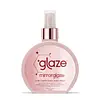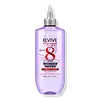What's inside
What's inside
 Key Ingredients
Key Ingredients

 Benefits
Benefits

 Concerns
Concerns

 Ingredients Side-by-side
Ingredients Side-by-side

Water
Skin ConditioningDipropylene Glycol
HumectantGlycerin
HumectantPEG-40 Hydrogenated Castor Oil
EmulsifyingPolysilicone-29
Parfum
MaskingPhenoxyethanol
PreservativeSilicone Quaternium-18
EmollientEthylhexylglycerin
Skin ConditioningBenzyl Salicylate
PerfumingTrideceth-6
EmulsifyingTrideceth-12
EmulsifyingHexyl Cinnamal
PerfumingLinalool
PerfumingLimonene
PerfumingCoumarin
PerfumingGeraniol
PerfumingCinnamyl Alcohol
PerfumingCitronellol
PerfumingEugenol
PerfumingCinnamal
PerfumingAnise Alcohol
PerfumingHelianthus Annuus Seed Oil
EmollientPanthenol
Skin ConditioningPropylene Glycol
HumectantVinegar
Cocos Nucifera Oil
MaskingLinum Usitatissimum Seed Oil
PerfumingSodium PCA
HumectantSodium Lactate
BufferingArginine
MaskingAspartic Acid
MaskingPCA
HumectantArgania Spinosa Kernel Oil
EmollientMacadamia Ternifolia Seed Oil
EmollientOlea Europaea Fruit Oil
MaskingPersea Gratissima Oil
Skin ConditioningGlycine
BufferingAlanine
MaskingSerine
MaskingPotassium Sorbate
PreservativeSodium Benzoate
MaskingUrtica Dioica Extract
AstringentValine
MaskingIsoleucine
Skin ConditioningProline
Skin ConditioningThreonine
Histidine
HumectantPhenylalanine
MaskingTocopherol
AntioxidantMalva Sylvestris Flower Extract
Skin ConditioningWater, Dipropylene Glycol, Glycerin, PEG-40 Hydrogenated Castor Oil, Polysilicone-29, Parfum, Phenoxyethanol, Silicone Quaternium-18, Ethylhexylglycerin, Benzyl Salicylate, Trideceth-6, Trideceth-12, Hexyl Cinnamal, Linalool, Limonene, Coumarin, Geraniol, Cinnamyl Alcohol, Citronellol, Eugenol, Cinnamal, Anise Alcohol, Helianthus Annuus Seed Oil, Panthenol, Propylene Glycol, Vinegar, Cocos Nucifera Oil, Linum Usitatissimum Seed Oil, Sodium PCA, Sodium Lactate, Arginine, Aspartic Acid, PCA, Argania Spinosa Kernel Oil, Macadamia Ternifolia Seed Oil, Olea Europaea Fruit Oil, Persea Gratissima Oil, Glycine, Alanine, Serine, Potassium Sorbate, Sodium Benzoate, Urtica Dioica Extract, Valine, Isoleucine, Proline, Threonine, Histidine, Phenylalanine, Tocopherol, Malva Sylvestris Flower Extract
Ingredients Explained
These ingredients are found in both products.
Ingredients higher up in an ingredient list are typically present in a larger amount.
Limonene is a fragrance that adds scent and taste to a formulation.
It's found in the peel oil of citrus fruits and other plants such as lavender and eucalyptus. The scent of limonene is generally described as "sweet citrus".
Limonene acts as an antioxidant, meaning it helps neutralize free radicals.
When exposed to air, oxidized limonene may sensitize the skin. Because of this, limonene is often avoided by people with sensitive skin.
The term 'fragrance' is not regulated in many countries. In many cases, it is up to the brand to define this term. For instance, many brands choose to label themselves as "fragrance-free" because they are not using synthetic fragrances. However, their products may still contain ingredients such as essential oils that are considered a fragrance.
Learn more about LimoneneParfum is a catch-all term for an ingredient or more that is used to give a scent to products.
Also called "fragrance", this ingredient can be a blend of hundreds of chemicals or plant oils. This means every product with "fragrance" or "parfum" in the ingredients list is a different mixture.
For instance, Habanolide is a proprietary trade name for a specific aroma chemical. When used as a fragrance ingredient in cosmetics, most aroma chemicals fall under the broad labeling category of “FRAGRANCE” or “PARFUM” according to EU and US regulations.
The term 'parfum' or 'fragrance' is not regulated in many countries. In many cases, it is up to the brand to define this term.
For instance, many brands choose to label themselves as "fragrance-free" because they are not using synthetic fragrances. However, their products may still contain ingredients such as essential oils that are considered a fragrance by INCI standards.
One example is Calendula flower extract. Calendula is an essential oil that still imparts a scent or 'fragrance'.
Depending on the blend, the ingredients in the mixture can cause allergies and sensitivities on the skin. Some ingredients that are known EU allergens include linalool and citronellol.
Parfum can also be used to mask or cover an unpleasant scent.
The bottom line is: not all fragrances/parfum/ingredients are created equally. If you are worried about fragrances, we recommend taking a closer look at an ingredient. And of course, we always recommend speaking with a professional.
Learn more about ParfumPropylene Glycol is an odorless, colorless liquid. As a humectant, it helps skin retain moisture. It also aids in delivering active ingredients.
Another role of this ingredient is preventing a product from melting or freezing. Propylene glycol also adds antimicrobrial properties to a product, elongating product lifespan.
This ingredient is considered an organic alcohol and commonly added into both cosmetics and foods.
Those with sensitive skin or conditions may develop a rash when using this ingredient.
Learn more about Propylene GlycolTocopherol (also known as Vitamin E) is a common antioxidant used to help protect the skin from free-radicals and strengthen the skin barrier. It's also fat soluble - this means our skin is great at absorbing it.
Vitamin E also helps keep your natural skin lipids healthy. Your lipid skin barrier naturally consists of lipids, ceramides, and fatty acids. Vitamin E offers extra protection for your skin’s lipid barrier, keeping your skin healthy and nourished.
Another benefit is a bit of UV protection. Vitamin E helps reduce the damage caused by UVB rays. (It should not replace your sunscreen). Combining it with Vitamin C can decrease sunburned cells and hyperpigmentation after UV exposure.
You might have noticed Vitamin E + C often paired together. This is because it is great at stabilizing Vitamin C. Using the two together helps increase the effectiveness of both ingredients.
There are often claims that Vitamin E can reduce/prevent scarring, but these claims haven't been confirmed by scientific research.
Learn more about TocopherolWater. It's the most common cosmetic ingredient of all. You'll usually see it at the top of ingredient lists, meaning that it makes up the largest part of the product.
So why is it so popular? Water most often acts as a solvent - this means that it helps dissolve other ingredients into the formulation.
You'll also recognize water as that liquid we all need to stay alive. If you see this, drink a glass of water. Stay hydrated!
Learn more about Water